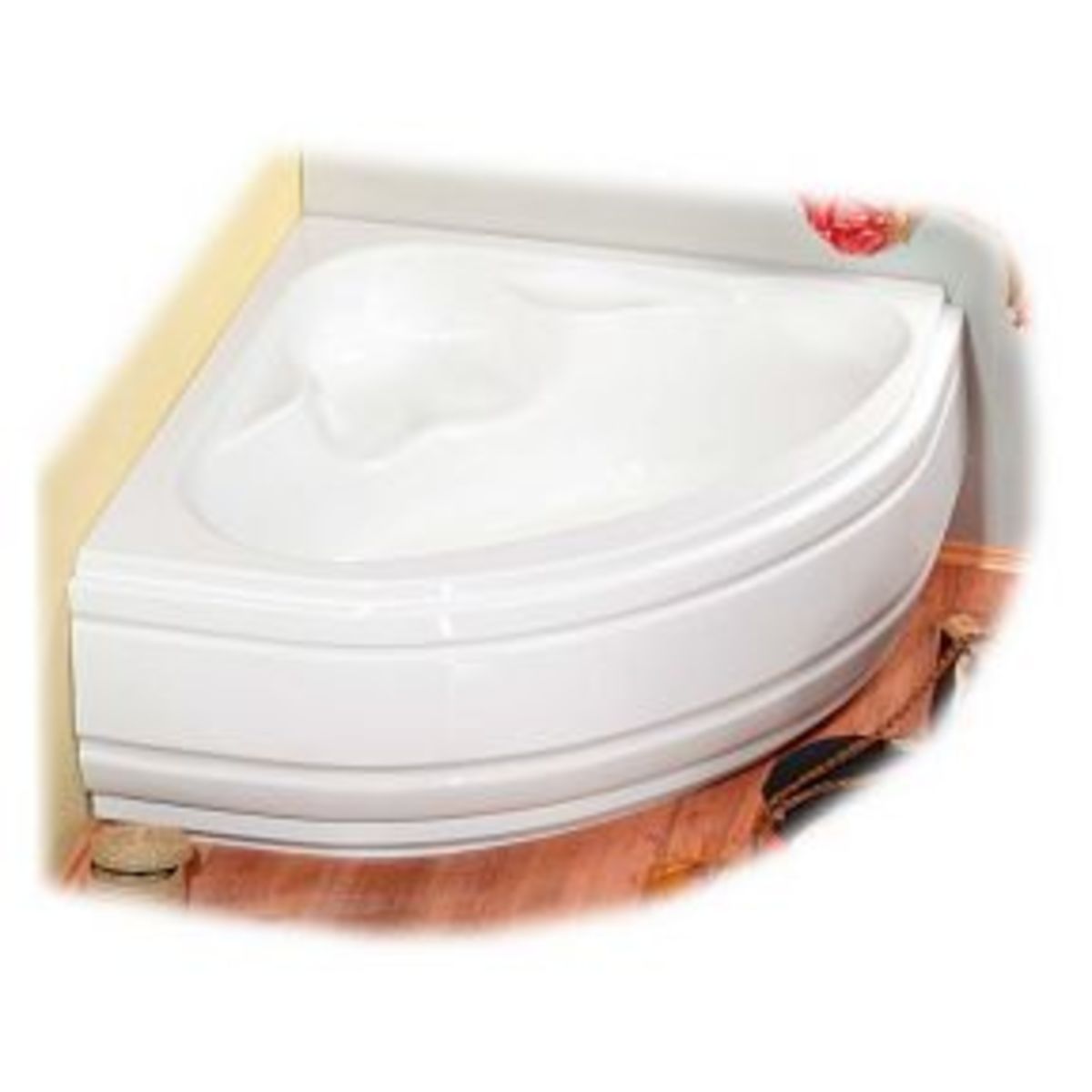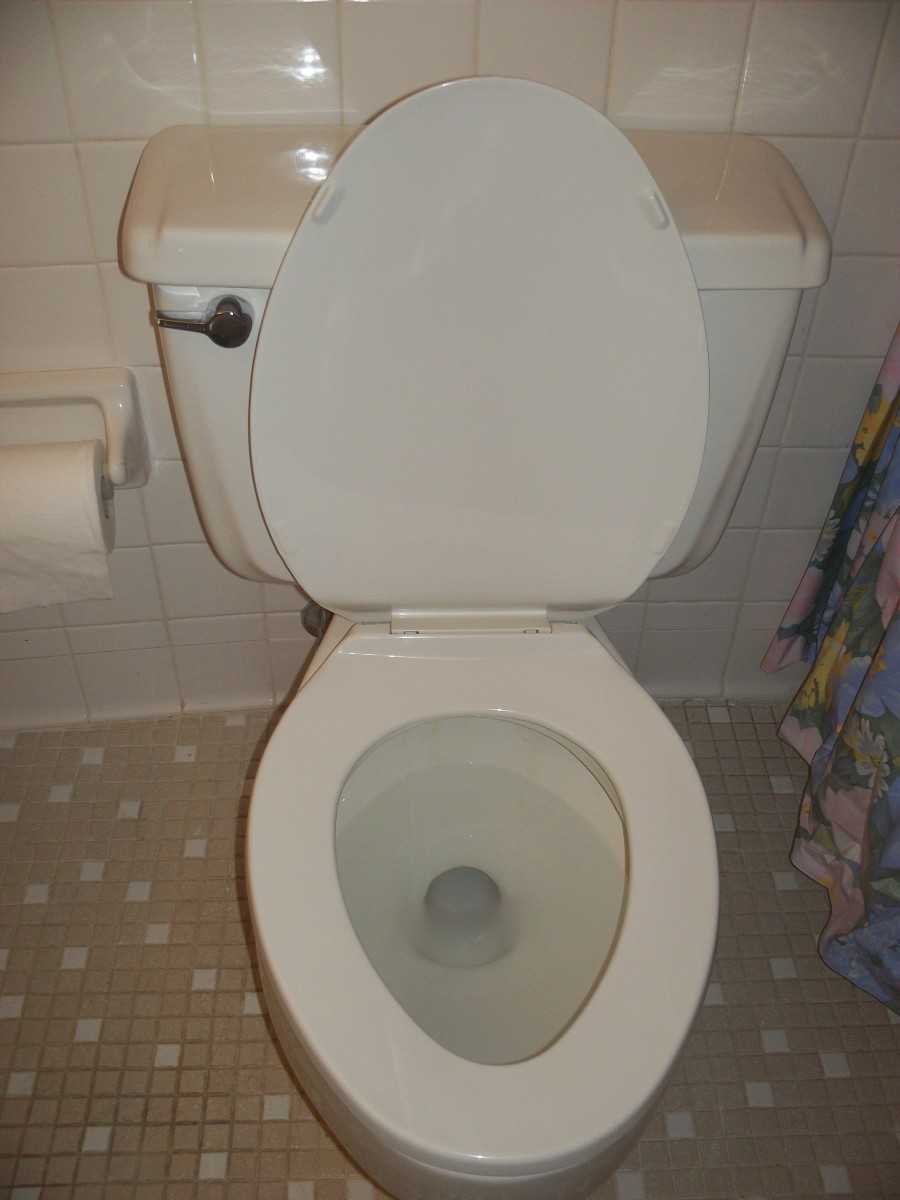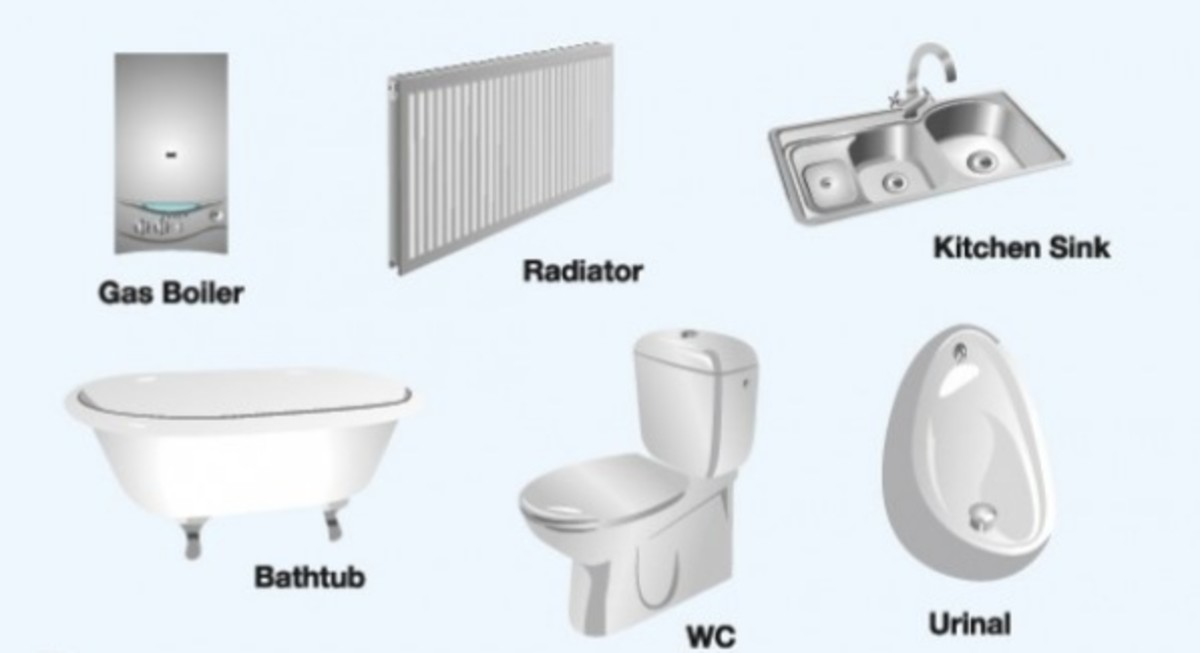What is Plumbing?
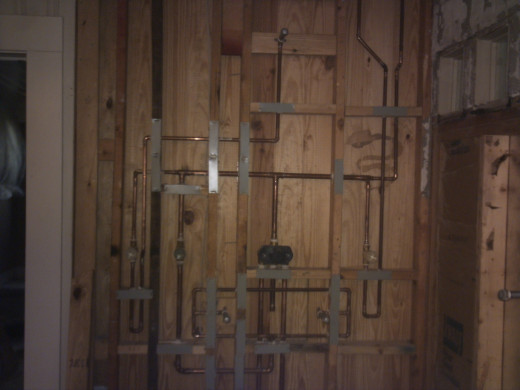
Plumbing is an important part of our daily lives, even though as American's, we generally take it for granted. Most of us don't even think about plumbing until its not working properly (that is, unless you are a plumber). But where does plumbing come from? Whats the history behind it? What is it made up of? How does it work? This hub will be about the concept of plumbing as a whole, and not really about residential or commercial plumbing.
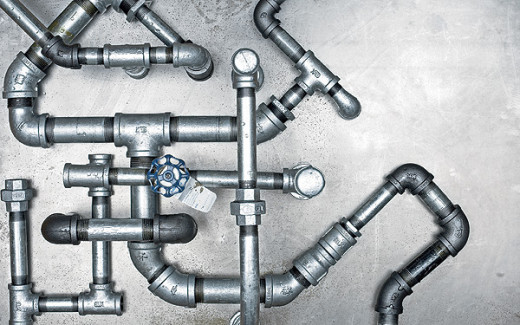
What is Plumbing?
Plumbing is a system comprised of pipes, valves, fittings, drains, and more, that is used to bring water in, and waste out, of a home or building. For this hub, we will focus on home plumbing (there are multiple types of plumbing, including hydraulic plumbing and gas line plumbing). When it comes to residential plumbing, as its called, pipes bring in fresh, clean water into the home, and has plumbing that brings waste water out of the home. In between, the water is routed throughout the home, some cold, some heated (if a water heater is used). The entire labyrinth of pipes, fittings, valves, drains, and other apparatuses and what-not's that deal with this transference of water and waste is considered to be a homes plumbing. Plumbing can also be referred to as the work that a plumber does. A plumber is someone that works on plumbing, and installs and repairs plumbing. Typically, the plumbing is all that is inside of a home, and doesn't include the waste system (typically a sewer or septic system), or the water supply, although it is connected to both (one feeds the water, and the other is where the waste water goes). So, plumbing is anything inside your home that has to deal with water movement.
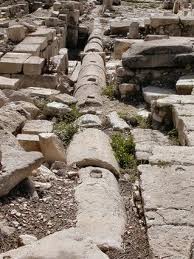
The History of Plumbing
Plumbing has been around for thousands of years, and can trace its roots back past the Roman Aquaducts. Plumbing's earliest recordings begin about 2,700 B.C., with the Greeks, Persians, Indians, Romans, and Chinese. These early civilizations had public baths, and a very primitive form of plumbing that used earthen pottery and a type of asphalt to prevent leaking. These early plumbing systems were used by the masses, as only the extremely rich (usually the ruler) would have actual indoor plumbing. The Romans where the first to use lead in the production of plumbing (although they did not know how dangerous lead pipes could be), and this is where we get the word plumbing from (Latin - plumbum - lead). Plumbing really hasn't seen much improvement over the course of time, with minor upgrades in materials, and upgrades in water quality and pressure. But to this day, the same principles stand fast as they did over the last 4,700 years.
Plumbing was pretty much a commodity for the rich and powerful from its earliest days until the 1800's, and typically, you would only find plumbing in public places. Typically, each area would have a wash house that would be shared by everyone. The rich in olden days were the only people that could afford indoor plumbing, and the very rich could even afford heated indoor plumbing. Some of the older Roman bath's have heated plumbing. Typically, if a building had indoor plumbing in the olden days, the waste water would just empty out into the street, or out of the building at some point. This was later found, with the dawn of modern medicine and the discovery of germs, to be the cause of a lot of sanitation problems. The growth of large citys, and this new found information on sanitation caused the rise of public health departments, and the push for more civilized plumbing systems that could deal with the sewage caused by plumbing. This led to plumbing becoming more widespread, and is the birth of modern water systems, and sewage systems, greatly improving the health of humanity.
Today, in modern times, our water comes from the same places as it did 100 years ago, although its generally healthier to drink. The reason is while not much has changed in the art and the way plumbing is done, the materials and the technology have gotten smarter. Pipes are made out of safer materials, and the water that enters our home is cleaner and purer. The waste water that exits our homes is dealt with more cleanly. Nowadays, water is generally piped though copper or PVC pipes, instead of lead, or galvanized iron. In fact, its not uncommon to still find those types of pipes in homes older than 1960. The sewage water that exits the home is better handled with the advent of sewers and sewage treatment plants, that actually purify (to a degree) the water before returning it back to the environment while some homes septic system takes care of the waste, and leeches the water out.
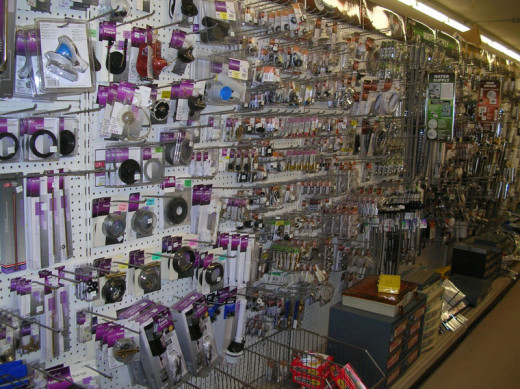
What is used in Plumbing?
Gravity is still the main component used in plumbing, although today's systems have the added benefit of being able to be pressurized. Ever since plumbing was invented, people have used gravity to plumb. In fact, the common toilet, uses gravity to flush. In the early days of plumbing, anything that could channel water was used to channel water. Wood, clay, lead, stone, and anything else that could be used as a building material was used. Today, typically homes plumbing is made out of PVC piping (plastic piping), and brass or copper. Early plumbing systems (typically before 1960), could have used lead, but lead has been discontinued due to health reasons.
There are 2 different types of "strait" plumbing, pipes and tubes. Typically, pipes are solid, thick walled, and made of plastic or metal. Tubes are generally thin, flexible and are typically made of plastic. These parts can be any length, and any width. Typically, the larger the width, the more important the pipe (such as a main line versus a smaller auxiliary line).
These parts are joined to the other sections of plumbing called fittings. These fittings are made up of a wide array of other pipes, and pipe fittings. Some are: valves, unions, tees, elbows, and other various fittings. These usually either connect multiple pieces of tubing or pipes (such as with a union joint), change the direction of the water (such as with an elbow), allow a junction in a pipe (such as a tee), or even cap off or regulate the flow of water (such as a valve).
Plumbing fixtures are generally what we see. These include faucets, toilets, showers, and more. Other less commonly thought about plumbing fixtures include drinking fountains, humidifiers, ice makers, eye wash stations, and more. This is typically where the fresh water system ends, and the waste water system begins.
Pipes and fittings and fixtures are all connected together using special methods. Sometimes, they are welded together (in the case of metal pipes). Typically, this is done with soldering, or even brazing, crimping, or compression fittings. Plastic pipes are typically connected with special chemicals that cause bond the 2 pieces with a watertight seal. If the ends of the pipes are threaded, the pipes can be screwed together, and special thread seal tape is used to help prevent leaking. Plumbing is held in place throughout a home with special brackets and holders, in order to prevent noises, twisting and breaking, and to help keep the flow of water constant. Believe it or not, but water flowing through the pipes can cause torque in the pipes, causing them to twist. This twisting can then cause a joint (or pipe) to weaken through time, and break.
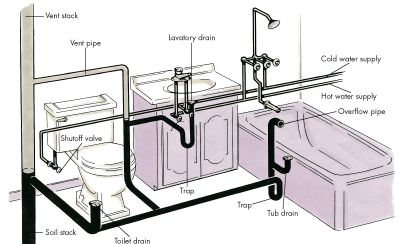
Different types of Plumbing systems
Plumbing is used to bring water into the home (the freshwater system) and waste water out of a home (sewage). Both aspects have multiple subcategories (fresh: hot and cold; sewage: raw and grey water . But that's not all that a plumbing system comprises of. Plumbing also has venting systems built in.
Typically, the plumbing system of a home begins with the freshwater system. Generally, cold water is piped from the water distribution center through main lines, that your home connects to. This is where the main water shut off valve is found for all homes. It then flows into the home, and typically the first place that it goes is into 2 lines. One of the lines then runs through the entire home, and is the cold water line. The second line is used for hot water, and is run through a hot water heater, and then to all the appliances and fixtures that require hot water (typically all sinks and baths). Once each line, the hot and cold water, reach the fixtures, the fresh water lines are complete.
The waste water lines begin with the drains on the fixtures. This is how the water, now considered waste water, leaves the home. Water that is collected from drains in the home is generally considered grey water and includes the water that comes out of a dishwasher, sinks, tubs/showers, and the such. Sewage water is typically reserved for the water that comes from the toilet. If a home is on a septic system, the grey water is leeched directly into the homes yard, while the sewage is filtered through the homes septic system. If a home is on a county sewer system, the both the grey water and sewage is dumped into the sewer, where it is taken to a treatment plant. The point where the waste and grey water lines exit the home is where the plumbing ends.
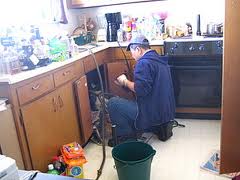
What is a Plumber
A plumber is the person that works on and installs plumbing. These people are a noble profession that has its roots over 4,700 years old. Since the invention of plumbing, there have been plumbers. Plumbers can be categorized as residential plumbers, meaning that they deal with household and private plumbing systems, and commercial plumbers, meaning that they deal with commercial and industrial types of plumbing systems. There is a difference, and the regulations used in both are different. Typically, residential plumbing systems are less complex and use less stringent parts and regulations. Commercial and industrial applications can include pressurized plumbing systems (including firefighting systems), and have more regulations (including water usage, waste, and more). Typically, a plumber will be licensed in one or the other, or both. Plumbers typically install new plumbing, and repair old plumbing. They are trained in all aspects of plumbing, including how to install plumbing, the laws regarding proper plumbing installation, and plumbing repair. If you have any plumbing problems, or need plumbing advice, calling up your local Destin plumber is the best thing to do.
- How Does a Toilet Work?
Everyone knows what a toilet looks like, what it is, and what its used for. But do you know how a toilet works? Where they came from? - How does a Septic and Sewer System Work?
You already learned how a toilet works, but now what about where it goes and what happens to our waste water? What are Septic systems and water treatment systems? Most don't know about these modern inventions that help keep some of the dirtiest parts - Plumbing 101
Plumbing is one of the things that most people don't think about, until there is a problem. knowing your enemy is half the battle, so get to know your plumbing system, and learn a few things you might not have known before you tackle your next plumbi - AJ's Plumbing Inc
AJ's plumbing, our Santa Rosa Beach and Dehttp://hubpages.com/hubtool/create/edit/3499991#stin Plumbers has continually served South Walton County and surrounding areas with excellence and gratitude. Call us now for! (850) 231-1473

